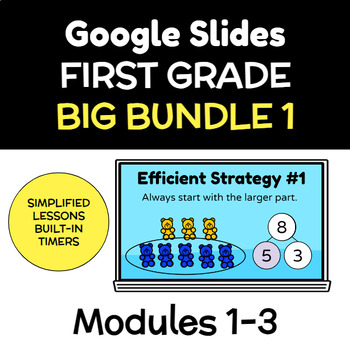First Grade Math BIG BUNDLE - MODULES 1-3 Original Eureka Aligned
- Google Drive™ folder

Products in this Bundle (17)
showing 1-5 of 17 products
Description
SIMPLIFIED, STUDENT FRIENDLY LESSON SLIDES!
Grade 1 Modules 1-3 ALL LESSONS
- Individual PPT presentation for each lesson
- Routines and Procedures for: Finding the Right Page, Sprints, Number Bond Dash, Application Problem, Problem Set Must Do Problems, and More.
- Fluency Activities
- Application Problem
- Concept Development with I Do, We Do, You Do
- Learning Target
- Problem Set with Must Do Problems aligned with Exit Tickets
- Reflection
- Exit Ticket with Timer and Learning Target Review
Included in This Bundle:
Module 1
Topic A: Decompositions - Part Part Whole - Lessons 1-3
Topic B: Counting On - Lessons 4-8
Topic C: Addition Word Problems - Lessons 9-13
Topic D: Strategies for Counting On - Lessons 14-16
Topic E: The Commutative Property and the Equal Sign - Lessons 17-20
Topic F: Addition Fluency Within 10 - Lessons 21-24
Topic G: Subtraction as an Unknown Addend Problem - Lessons 25-27
Topic H: Subtraction Word Problems - Lessons 28-32
Topic I: Strategies for Subtraction - Lessons 33-37
Topic J: Subtraction Fluency Within 10 - Lessons 38-39
Module 2
Topic A: Counting On or Making Ten to Solve Result Unknown and Total Unknown Problems - Lessons 1-11
Topic B: Counting On or Taking from Ten to Solve Result Unknown and Total Unknown Problems - Lessons 12-21
Topic C: Strategies for Solving Change or Addend Unknown Problems - Lessons 22-25
Topic D: Varied Problems with Decompositions of Teen Numbers as 1 Ten and Some Ones - Lessons 26-29
Module 3
Topic A: Indirect Comparison in Length Measurement Lessons 1-3
Topic B: Standard Length Units Lessons 4-6
Topic C: Non-Standard and Standard Length Units Lessons 7-9
Topic D: Data Interpretation Lessons 10-13
Also includes notes about procedures, routine, and setup to help teachers more effectively teach Math Lessons.
STUDENT FRIENDLY version allows students to have gradual release of responsibility with I Do, We Do, You Do included.
COMPLETELTY EDITABLE slides allow you to customize to fit the needs of your students. Please view in Slideshow mode, as animations and layered graphics can make template look odd in editing mode.
***Interactive White Board***
- These slides are meant for use with an interactive white board, and have blank spaces for TEACHER MODELING and STUDENT PRACTICE problems. Animations do not fill in all blanks automatically.





